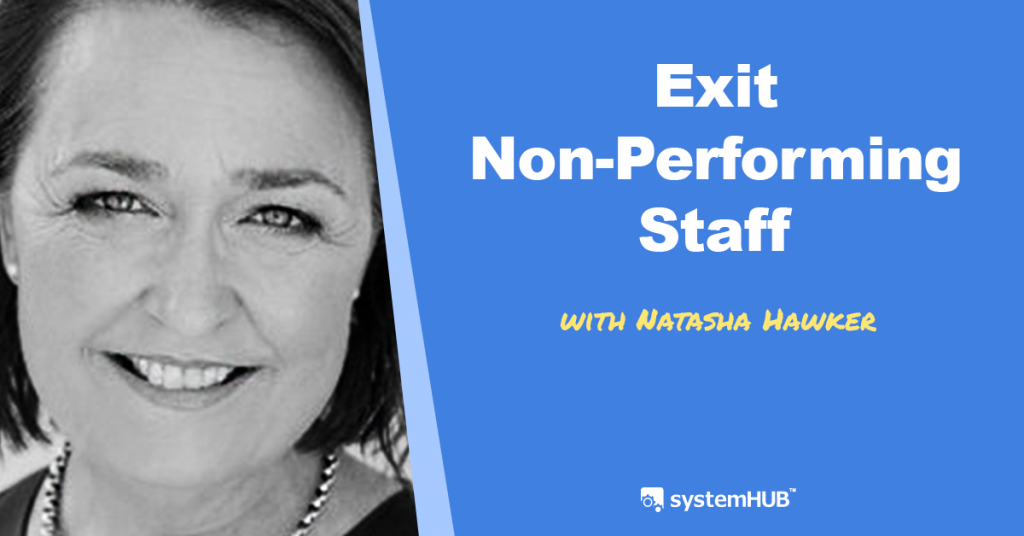Natasha Hawker | How to Exit Non-performing Staff
- Department: Human Resources

Overview
This document defines the process of exiting people who are not performing within your business while avoiding costly legal breaches. This is a system to fire someone legally and take action without feeling afraid you might be sued.
=-=-=-=-=-=
System Architect: Natasha Hawker
Website: www.employeematters.com.au
Generated as part of the www.BusinessSystemsSummit.com
Video
The Process
Step 1: Have all the foundation steps in place.
- Review and complete the checklist “Checklist_WhatDoIDoIfAnEmployeeIsNotPerforming.pdf” under the attachments section below.
- Have evidence – recorded calls, instructions that you had to repeat multiple times etc.
- State your expectations – tell them what you expect, what success looks like.
- Communicate with the employee that they are not performing and not meeting your expectations.
- Confirm the expected levels of performance. Ensure they are reasonable.
- Ask why performance is sub-par, find out if there’s a valid reason for it.
- Ask whether there are any extenuating circumstances for the performance.
- Arrange for additional training to adjust the performance.
- Legally you need to offer the employee a support person if going through any of the following conversations: redundancy conversation, restructure or performance management conversation, or misconduct conversation.
- If the individual is positive that they don’t want a support person, get them to sign a document that they’ve waived this right. If they are not prepared to sign that document, note that in your documents.
Step 2: Steps prior to a performance management meeting.
- Counselling sessions – suitable for minor issues.
- Employer to review the performance of the employee after the counselling session.
- A counselling session can occur a couple of times before moving to more formal warnings.
- Documentation is important – make a file note of the sessions that you’ve had.
- Warnings – no more than 3 strikes.
- It is recommended that all warnings, including verbal, be documented.
- Prior to the final warning, and potential termination meeting, the employee must be in no doubt of the seriousness of the situation and that termination can be an outcome.
- Training – it is imperative that further training or support has been offered, including additional external training or mentor allocated.
- Instigate a without prejudice conversation – this is an alternative, off the record mutual separation discussion.
- In this case, you must get the employee to sign a date of release, that is sought by a lawyer.
Step 3: Script the performance management meeting.
- Plan the meeting. Script the conversation and practice it with someone else.
Step 4: Conduct a performance meeting.
- Ensure that you are prepared, that all paperwork has been completed as much as it can be prior to the meeting.
- Plan the meeting, have notes to guide you to be sure you cover everything.
- Suggestion! Ideally, have someone available to take notes.
- Book a quiet and private meeting space.
- Book the meeting with the individual stating it is to discuss their performance and they are welcome to bring a support person.
- Explain at the beginning the purpose of the meeting and the roles of the participants.
- Walkthrough each of the performance issues giving the employee a chance to respond. Where appropriate, provide evidence of the current performance level being achieved.
- Ask employee whether there’s anything that would assist them to improve their performance. Consider all requests, and then confirm what’s possible and what’s reasonable.
- Explain the required level of performance and the timeline to be reached.
- Summarise the outcomes of the meeting and next steps, and if the next meeting is termination as a potential outcome.
- After the meeting, the Minutes should be countersigned.
- If the employee is unwilling to do this, make a note of this fact.
Step 5: Deal with the emotional side.
- Be prepared and stay calm.
- Offer a short break.
- Always have tissues.
Email Templates
Attachments
Additional Resources
Different type of non-performers in your business.
- Non-performance: the employee is not performing adequately in their role.
- Misconduct: the employee has an inappropriate attitude.
- Gross-misconduct: an employee verbally or physically insulted someone, or committed fraud.
Reasons why we hire non-performers:
- Candidate’s skills are not assessed effectively.
- Hiring Manager lacks interview skills or technique.
- The employee does not have an accurate job description.
- The manager does not communicate effectively.
- The manager does not provide timely and frank feedback.
- Sub-par performance is not dealt with effectively.